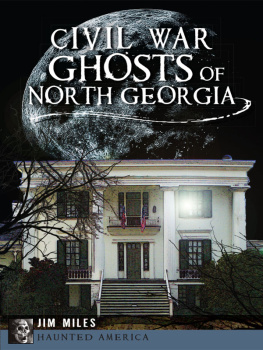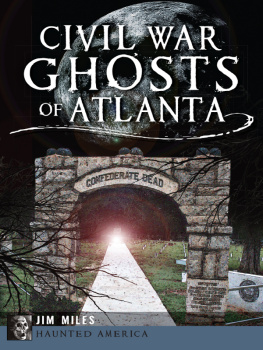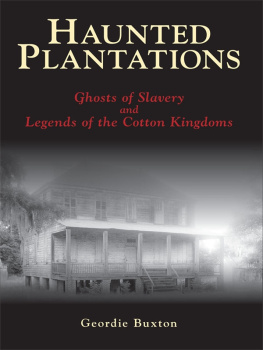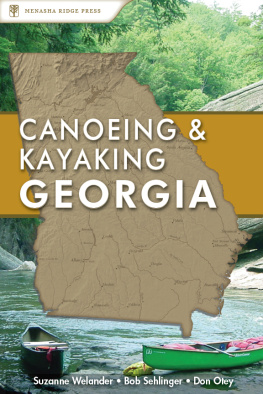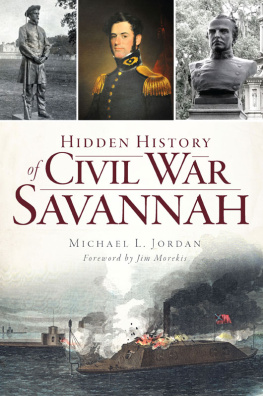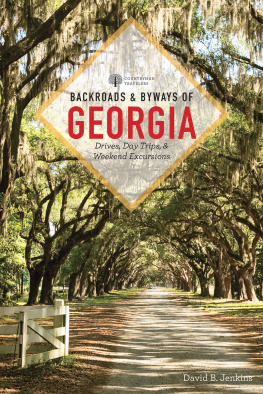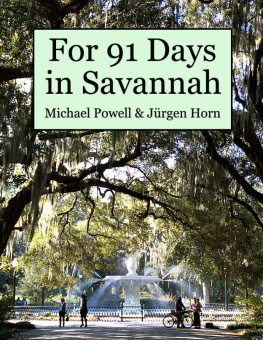Published by Haunted America
A Division of The History Press
Charleston, SC 29403
www.historypress.net
Copyright 2013 by Jim Miles
All rights reserved
First published 2013
e-book edition 2013
Manufactured in the United States
ISBN 978.1.62584.649.5
Library of Congress CIP data applied for.
print edition ISBN 978.1.62619.191.4
Notice: The information in this book is true and complete to the best of our knowledge. It is offered without guarantee on the part of the author or The History Press. The author and The History Press disclaim all liability in connection with the use of this book.
All rights reserved. No part of this book may be reproduced or transmitted in any form whatsoever without prior written permission from the publisher except in the case of brief quotations embodied in critical articles and reviews.
For the aunts: Flora Craven, Dink Ridgeway, Joann Hawkins and Lindy Bayles.
CONTENTS
INTRODUCTION
Civil War historians concentrate on northern Georgia and Atlanta, where the great battle of Chickamauga and the multiple conflicts resulting in the conquest of Atlantaone of the Confederacys most important manufacturing centersoccurred. But Georgia is a huge state, the largest east of the Mississippi River, and much important Civil War activity occurred in the two-thirds of Georgia found in the central, coastal, and southern parts of the state.
Shermans March to the Sea is a classic campaign studied in military schools worldwide and decisive in the American Civil War. William Sherman occupied Atlanta for several months before chasing John Hood into northern Alabama. He then returned to Atlanta to plan his next campaign. Sherman picked sixty thousand battle-hardened veterans to march across Georgia to the Atlantic Ocean at Savannah. Shermans March is famous in Civil War history. The Federals ripped the heart out of the Confederacy, devastating a region sixty miles wide and three hundred miles long, proving the war was nearly over.
Savannah is one of Americas most interesting cities, and much of its history is devoted to the struggle to safeguard the port during the war. Savannah has long been a major American port, dating back to colonial days. As a Confederate port, Savannah was effectively sealed off from blockade runners, but because the city was approached by rivers and guarded by swamps, it held out until Shermans army arrived in December 1864. Savannah has been called Americas Most Haunted City, and many of the citys ghosts belong to the Civil War era. Some haunt Savannahs well-preserved forts, while others are found in the many old houses, hotels and cemeteries.
Central Georgia, which contains well over half of Georgia, includes two of the Confederacys major industrial citiesColumbus and Maconwhich produced considerable weapons and other military goods. The area also contains the farmlands that provided troops in both the western and eastern theaters with nourishment. Because military action reached the region only late in the war, little was destroyed and much remains preserved. Columbus and West Point fell after Lees surrender, and the same Union cavalry raid that took those cities ended in Macon without a shot fired. In the last act of the war, Confederate president Jefferson Davis entered the region seeking escape from Federal pursuers, but he was captured at Irwinville.
As the war progressed, the Confederacy was faced with a serious problem. Many Union soldiers had been captured, but more of the fledgling nation was vulnerable to attack and raids. Also, the Federals, noting that they could easily replace lost prisoners while the Confederacy could not, began a policy of not exchanging prisoners. Andersonville prison, a large prisoner of war camp located deep in Georgia, fatally lacked clean water, adequate food and decent shelter. By the time this tragic situation played out, thirteen thousand Union prisoners had died.
Throughout this region, thousands of wounded and ill soldiers received care in hospital centers.
Death and misery plagued this part of Georgia, and the ghosts of soldiers killed by battle, inadequate medical care and deprivation in prisons haunt rural areas, small towns and cities. Civil War ghosts abound, concentrated on battlefields, prison sites and hospital centers.
PART I
PHANTOMS ALONG SHERMANS MARCH
Shermans March was a grand, largely carefree campaign to the overpowering Federals, and the worst nightmare for the defenseless civilian population. This campaign still haunts the South, and it left a number of ghosts in its wake.
HENRY COUNTY
The End of the Atlanta Campaign, the Beginning of Shermans March
The eastern edge of Henry County is bordered by the South River. People could cross the stream on Butlers Bridge until it was dismantled. C.W. Hollingsworth owned a dairy farm that bordered the bridge.
It was always a spooky place, his grandson Wes stated. A lot of people didnt like it, even in the daytime.
C.W. told Wes that Union troops used Butlers Bridge Road at the start of Shermans March. The Union general sent an advance guard of ten scouts to examine the route. The scouts were captured, probably while looting, and hanged from trees by their Confederate captors. A local legend said if someone went there on a dark night and sang Dixie, the bodies of the executed men would appear, dangling from old oak trees.
On a daring teenaged expedition, Wes and buddies went to the bridge on a dark night, a cassette tape blaring Dixie on the stereo. As the song played, the boys saw the bodies hanging from the trees all around them.
Wes said some locals refused to cross the bridge after midnight, and stories were told of cars stalling on the span and terrified stranded motorists seeing ghostly apparitions and hearing the sounds of combat and fighting.
Theres always been something down there you cant understand, Wes said. Its a weird place.
Shermans Right Wing, under Major General Oliver O. Howard, left Atlanta for Savannah via the McDonough Road and passed through McDonough on November 1516, 1864. Skirmishes between Federal cavalry under Judson Kilpatrick and Confederate cavalry commanded by Alfred Iverson occurred on the edges of the march. Federals burned two churches, slaughtered animals in a third and destroyed mills as they progressed.
NEWTON COUNTY
Gaither: The Plantation Visited by Shermans Bummers
During mid-November 1864, one of the four columns of Shermans army, numbering fifteen thousand men, swept through Newton County like a plague of locusts, stealing food, fodder and personal treasures, and torching much of what they could not carry away. A thin scattering of Confederates withdrew before this inexorable wave, and it is believed that several hid at the Gaither Plantation until the Federals passed.
One day several years ago, during a wedding celebration, a ghostly apparition dressed in a gray uniform, presumably a Confederate, was seen in the basement. A search revealed no one present. On another occasion, a reenactor in full uniform observed not a dead Confederate, but a woman, rocking and nursing an infant in an upstairs bedroom.
Amber Pittman, reporter for the Covington News, was told that Confederates had been hidden in the attic, where footsteps thought to belong to the soldiers are heard. Also, shadow people that are believed to be the spirits of Southern soldiers have been observed walking the grounds.




